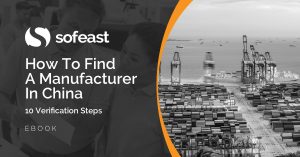Have you inquired about a production facility, only to be told production is done “in the village”?
That’s quite common if you purchase arts & craft, Christmas ornaments, certain textile products, and similar goods, from Zhejiang all the way to East Guangdong.
The production work is distributed across a number of small family-run workshops and/or given to people who will do manual work in their homes — and often both at the same time. Let’s look at each of these situations.
The network of small family-run workshops
Someone in the ‘network’ gets an order. A cousin is specialized in making that type of product, so he will manage the manufacturing. Another family member might provide the paint, the glue, the wood…
They often suffer from ‘feast or famine’, and they have adapted to that reality. All the production operators may be part-timers, doing work on their family farm during certain seasons.
It all tends to be run in a scrappy way, in long amortized buildings or in homes. Whenever some machining or other type of processing is required, manufacturing has to take place in a workshop.
However, much of the preparation and assembly work is done ‘at home’.
Home work
How does it work when it is done in homes? Grandmothers from the neighborhood come and pick up some big baskets/bags of materials, and they have to return it all within a few days.
Buyers and their inspectors don’t see that, but many suppliers are relatively open about the situation.
Implications of such a setup
The big advantage is the low cost. There is usually no engineering content in those products and very little quality control along the whole cycle.
From a traditional social compliance point of view, it is horrible, as there is a chance a child gives a helping hand to the grandmother. Oh, and they usually don’t comply with labor laws – they pay by the piece and there is no other consideration (number of hours, payment of social security…).
Some people close their eyes because it means another source of revenue for poor families in the countryside, and I understand that.
Is the operation sustainable?
If they do anything that may pollute the air or water, they can be closed abruptly anytime. That includes various types of painting and other surface treatment. You might lose your supplier overnight.
So far, I haven’t heard of such operations be caught and closed for noncompliance to labor laws, but they might get a heavy fine. That’s always a risk.
When it comes to minimizing delays, all tends to be fine until you hit their peak production season. There are usually no planning systems in place, so even they can be surprised and find themselves suddenly 10 days behind schedule.
From a quality standpoint, it is really scary.
Family-run production facilities that are distributed in the countryside don’t come with good management systems, proper training of the key staff, good documentation of the way processes are set up or (if that’s even done) controlled, etc. In short, the results are inconsistent.
One season, by chance the key person does a nice job, and another season he is working at his family’s farm and someone else does the same job in a different way.
Or some home workers did the operation in one way, and others in another.
Let’s not even mention the protection of your intellectual property. If they are making your new product, there is basically no way to control who sees your product, where some samples end up (i.e. in how many showrooms they will show up), and so on.
As a buyer, how to keep tabs on the situation?
Some buyers are happy to enjoy the low prices and can live with the risks.
My suggestion for them is simple.
First, ask the supplier for details. If they can’t just say what processes are always going to be done in what facility, this setup is synonymous with inconsistent performance.
Get the company’s official name, and get the address. From there, you can do some background checks and send an auditor to the factory.
You can try to have them sign a manufacturing agreement that forbids manufacturing outside of the authorized place(s), and see their reaction. That might prompt them to disclose more information in the hope that you accept their distributed setup.
If it all looks reasonably good, tell them you will do some regular monitoring during production. It means you will know whether some production steps are, or are not, taking place at the authorized facility. Again, it might trigger an interesting reaction.
And then, arrange proper monitoring, or at least end-of-line product inspections. There will probably be inconsistencies. You want to know if they are marginal or if they make the product unusable/unsellable on your market.
******
Do you have any experience with production taking place outside of the usual factory environment in China’s countryside? Let me know by commenting, please.
Are you wondering how to find a manufacturer in China who is well-suited to your needs and can also deliver on their promises?
Sofeast has developed 10 verification steps to help you find the right manufacturer. They’re shared in this FREE eBook: “How To Find A Manufacturer In China: 10 Verification Steps.”
It covers:
- Background checks
- Manufacturing capabilities
- Quality system auditing
- Engineering resources
- Pricing, negotiation, & contracts
- …and much, much more
Just hit the button below to get your copy:


